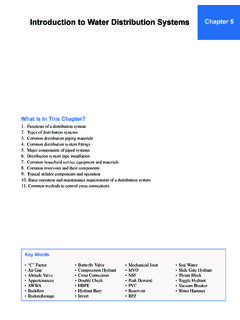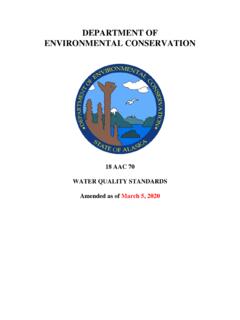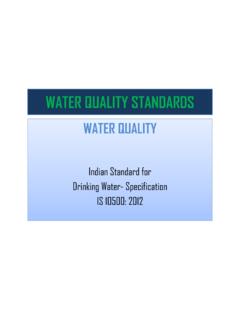Transcription of Introduction to Water Sources Chapter 3 - Alaska
1 Chapter 3 What Is In This Chapter ?1. Definition of surface water2. Examples of surface water3. Advantages and disadvantages of surface water4. Surface Water hydrology 5. Raw Water storage and flow measurements6. Surface Water intake structures7. The types of pumps used to collect surface water8. Definition of groundwater9. Examples of groundwater10. Advantages and disadvantages of groundwater11. Groundwater hydrology12. Three types of aquifers13. Well components14. Data and record keeping requirements15. Transmission lines and flow meters16. Groundwater under the direct influence of surface waterIntroduction to Water SourcesKey Words Aquifer Baseline Data Caisson Cone of Depression Confined Aquifer Contamination Drainage Basin Drawdown Flume Glycol Groundwater Impermeable ntu Parshall flume Permeability Polluted Water Porosity Raw Water Recharge Area Riprap Spring Static Water Level Stratum Surface Runoff Surface Water Unconfined Aquifer Water Rights Water Table Watershed Weir62 Introduction to Water SourcesChapter 3 This lesson is a discussion of the components associated with collecting Water from its source and bringing it to the Water treatment ContentThis lesson will focus on surface water1 and groundwater2, hydrology.
2 And the ma-jor components associated with the collection and transmission of Water to the Water treatment of WaterThree ClassificationsThe current federal drinking Water regulations define three distinct and separate Sources of Water : Surface Water Groundwater Groundwater under the direct influence of surface Water (GUDISW)This last classification is a result of the Surface Water Treatment Rule. The definition of what conditions constitute GUDISW, while specific, is not obvious. This classifi-cation is discussed later in this Water is Water that is open to the atmosphere and results from overland flow. It is also said to be the result of surface runoff 3. These are two ways of saying the same thing. Examples of Surface WaterSpecific Sources that are classified as surface Water include the following: Streams, Rivers, Lakes Man-made impoundments (lakes made by damming a stream or river) Springs4 affected by precipitation that falls in the vicinity of the spring (af-fected means a change in flow or quality) Shallow wells affected by precipitation (affected means a change in level or quality) Wells drilled next to or in a stream or river Rain catchments Muskeg and tundra pondsAdvantages and Disadvantages of Surface WaterThere are both advantages and disadvantages to surface Water : Advantages The primary advantages to using surface Water as a Water source include the following: It is easily located.
3 It takes no sophisticated equipment to find a surface Water Water1 Surface Water Water on the earth s surface as distinguished from Water underground (groundwater).2 Groundwater Subsurface Water occupying a saturated geological for-mation from which wells and springs are Surface Runoff The amount of rainfall that passes over the surface of the Spring A surface feature where, without the help of man, Water issues from rock or soil onto the land or into a body of Water , the place of issu-ance being relatively restricted in 3 Introduction to Water Sources In many parts of the US, considerable data is available on quantity and qual-ity of existing surface Water supplies. Surface Water is generally softer than groundwater, which makes treatment much simpler.
4 Disadvantages The most common disadvantages to using surface Water as a Water source include the following: Surface waters are easily polluted5 (or contaminated) with microorganisms that cause waterborne diseases and chemicals that enter the stream from sur-face runoff and upstream discharges. The turbidity (measured as NTU6) of a surface Water source often fluctuates with the amount of precipitation. Increases in turbidity increase treatment cost and operator time. The temperature of surface Water fluctuates with the ambient temperature. This makes it difficult to produce consistent Water quality at a Water treat-ment plant. The intake structure may become clogged or damaged from winter ice, or the source may be so shallow that it completely freezes in the winter.
5 This is a common problem with surface Water Sources in the arctic. Removing surface Water from a stream, lake, or spring requires a legal right, referred to as a Water right. Water rights7 in Alaska are obtained from the Department of Natural Resources (DNR). For many systems in Alaska , the source Water is at its worst possible qual-ity during the time of the year when the community needs to fill or top off its storage tank. This happens late in the summer when glacially fed streams have turbidities of 1000 ntu or greater. Using surface Water as a source means that the purveyor is obligated to meet the requirements of the Surface Water Treatment Rule (SWTR) of the State Drinking Water Regulations. This rule requires that, in most instances, any surface Water source must have a filtration system .
6 Surface waters that are high in color, especially color that is the result of decaying vegetation, have the potential to produce high levels of Total Triha-lomethanes (TTHM). These chemical compounds are formed when chlorine is added to the Water . The problem with the TTHM is that some of them are carcinogenic (can cause cancer) and are referred to as disinfection by-prod-ucts (DBP).IntroductionA basic understanding of the movement of Water and the things that affect Water quality and quantity are important to those who manage and operate Water systems. The study of these items is called hydrology. The components of hydrology include the physical configuration of the watershed, the geology, soils, vegetation, nutrients, energy, wildlife, and the Water BasinThe area from which surface Water flows is called a drainage basin8.
7 With a sur-face Water source, this drainage basin is most often called the watershed9. When we are dealing with a groundwater supply, this area is called the recharge area10. The 5 Polluted Water Water than con-tains sewage, industrial wastewater, or other harmful or objectionable NTUs The units of measure of turbidity, Nephelometric Turbidity Units, the measurement as made with a nephelometric Water Rights The rights, acquired under the law, to use the Water ac-cruing in surface or groundwater, for a specified purpose in a given manner and usually within the limits of a given time Water Hydrology8 Drainage Basin An area from which surface runoff or groundwater re-charge is carried into a single drainage system , also called a catchment area, watershed.
8 Or drainage Watershed A drainage basin from which surface Water is Recharge Area One from which precipitation flows into the under-ground Water to Water SourcesChapter 3drainage basin is difficult to identify when we are referring to a large river such as the Yukon. However, on a smaller river, stream or lake the area is defined by marking on a map an outline of the basin defined by the ridge of the mountains that surround the OF RECHARGEWATER SHED Review1. What are the three Sources of drinking Water ?2. What do the letters GUDISW mean?3. A muskeg pond is an example of what type of Water source?4. What are two of the advantages of surface Water Sources ? 5. The study of the properties of Water - its distribution and behavior - is called?
9 6. What is the area called that directly influences the quantity and quality of surface Water ?Area MeasurementsThe area of the basin is commonly measured in square miles, sections, or acres. If you are taking Water from a surface Water source, it is desirable to know the size of the of the Basin A parcel of ground such as a drainage basin can be identified by and described by standard terms used in land descriptions and surveying. This description is based on a series of horizontal and vertical lines that form a rectangle system . The ability to describe properly the location of a drainage basin, well, or surface Water intake is important when communicating with the Department of Natural Resources (DNR) and 3 Introduction to Water SourcesBaseline DataGathering precipitation and flow data plus Water quality data is called baseline data11.
10 This data is essential for long-term planning and determining the impact of activities in a drainage water12 storage areas are constructed to meet peak demands and/or to store wa-ter to meet demands when the flow of the source is below the StorageNatural storage can be found in lakes like the one used by Haines and large rivers like the Yukon used by St. Mary s. Natural storage includes muskeg and tundra ponds used by logging camps in the Southeast, in oil field camps, and by resorts in the arctic region. Man-made StorageIn many areas, there are no natural storage areas, and dams must be built. These dams can be either masonry or embankment dams. There are three different concrete masonry dam designs: Gravity dam Buttress dam Arched damGravity damButtress damArched dam11 Baseline Data The Water quality data, precipitation data, and stream flow data accumulated from a drainage basin or groundwater supply when there is little or no activity in the Raw Water Water that has not been treated and is to be used, after treatment, for drinking Water Storage66 Introduction to Water SourcesChapter 3In Alaska , the most common dam used for potable Water is a concrete gravity dam less than 30 feet in height.









